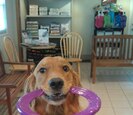Canine Care Guides
Pneumonia in Dogs
-
Most lung tissue is made up of tiny clusters of air “balloons” (called alveoli). Each balloon is lined by a thin layer of cells and surrounded by a network of very small blood vessels. When you breathe in, air fills the balloons. The cells in the lining and the small blood vessels exchange oxygen from the air for carbon dioxide, which you then breathe out. The main pathway from the lungs to the outside of the body consists of the trachea (the large airway that begins at the back of the throat and continues down into the lungs) and the nostrils.
Read More Polyuria and Polydipsia
-
Polyuria (PU) and polydipsia (PD) are the medical terms used to describe excessive urination and excessive drinking, respectively. Because these two abnormalities tend to occur together, the abbreviation PU/PD is commonly used.
Read More Porphyromonas in Canine Dental Disease
-
When a dog’s teeth are not properly cleaned or cared for on a regular basis, plaque and tarter can build up on the tooth surface and underneath the gumline. This material can irritate the gums, causing inflammation known as gingivitis. If left untreated, gingivitis can lead to the development of periodontitis, which is the infection and inflammation of structures that support the teeth. Periodontal disease tends to include both gingivitis and periodontitis.
Read More Potassium Bromide Level Test
-
Potassium bromide is used alone or in combination with other anti-convulsant medications to help control and prevent seizures. Potassium bromide is administered primarily to dogs and less frequently to cats.
Read More Pregnancy in Dogs
-
Pregnancy is the time between conception and birth when puppies develop and grow inside the mother’s uterus. By day 40, the fetus has eyelids, claws, and hair, and the gender is apparent. While toy breeds tend to have smaller litters of one to four puppies, larger breeds may carry as many as eight to 12 puppies. After 56 and 70 days, or about 2 months, puppies are ready to be born.
Read More





